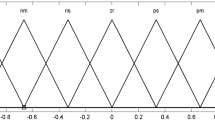Abstract
The article discusses ways to build high-speed defuzzifiers. Two procedures for modifying the defuzzification model based on the area ratio method are presented. A limitation of the proposed method with two high-speed procedures is the use of only triangular or singleton membership functions. The main aim of the research is to test the hypothesis about the possibility of changing the type of the transient process during learning of the fuzzy MISO-system and to study the properties of the influence of the weight coefficient on the speed of its learning. The study tested the hypothesis of the presence of the additivity property in the high-speed defuzzifier with procedures I and II. Experimental researches have confirmed these hypotheses. The architecture of a fuzzy MISO-system based on the area ratio method with two high-speed procedures is shown in the article. Also in the article, firstly, graphs are presented that simulate the work of the center of gravity method, the area ratio method, and two high-speed procedures. Secondly, the article shows graphs that simulate the learning process of a fuzzy MISO-system.
Access this chapter
Tax calculation will be finalised at checkout
Purchases are for personal use only
Similar content being viewed by others
References
A.M. Anter, S. Bhattacharyya, Z. Zhang, Multi-stage fuzzy swarm intelligence for automatic hepatic lesion segmentation from CT scans. Appl. Soft Comput. 96, 106677 (2020)
M.V. Bobyr, S.A. Kulabukhov, Simulation of control of temperature mode in cutting area on the basis of fuzzy logic. J. Machinery Manuf. Reliab. 46(3), 288–295 (2017)
M. Bobyr, V. Titov, A. Belyaev, Fuzzy system of distribution of braking forces on the engines of a mobile robot. MATEC Web Conf. 79, 01052 (2016)
D.R. Keshwani, D.D. Jones, G.E. Meyer, R.M. Brand, Rule-based Mamdani-typefuzzy modeling of skin permeability. Appl. Soft Comput. 8, 285–294 (2008)
V.I. Syryamkin, S.V. Gorbachev, M.V. Shikhman, Adaptive neuro-fuzzy classifier for evaluating the technology effectiveness based on the modified Wang and Mendel fuzzy neural production MIMO-network. IOP Conf. Ser.: Mater. Sci. Eng. 516(1), 012037 (2019)
S. Gorbachev, N. Gorbacheva, S. Koynov, A synergistic effect in the measurement of neuro-fuzzy system. MATEC Web Conf. 79, 01065 (2016)
V.I. Syryamkin, S.V. Gorbachev, M.V. Shikhman, Adaptive fuzzy neural production network with MIMO-structure for the evaluation of technology efficiency. IOP Conf. Ser.: Mater. Sci. Eng. 516(1), 012010 (2019)
S. Gorbachev, V. Syryamkin, High-performance adaptive neuro-fuzzy classifier with a parametric tuning. MATEC Web Conf. 155, 01037 (2018)
Extractive text summarization using deep natural language fuzzy processing
G. Neelima, M.R.M. Veeramanickam, S. Gorbachev, S.A. Kale, Int. J. Innov. Technol. Explor. Eng. 8(6 Special Issue 4), 990–993 (2019)
A. Piegat, Fuzzy Modelling and Control (Physica-Verlag, Heidelberg, 2001). https://doi.org/10.1007/978-3-7908-1824-6
W.V. Leekwijck, E.E. Kerre, Defuzzification: criteria and classification. Fuzzy Sets Syst. 108, 159–178 (1999)
M.V. Bobyr, S.G. Emelyanov, A nonlinear method of learning neuro-fuzzy models for dynamic control systems. Appl. Soft Comput. 88, 106030 (2020)
M.V. Bobyr, A.S. Yakushev, A.A. Dorodnykh, Fuzzy devices for cooling the cutting tool of the CNC machine implemented on FPGA. Measurment (2020). https://doi.org/10.1016/j.measurement.2019.107378
Author information
Authors and Affiliations
Editor information
Editors and Affiliations
Rights and permissions
Copyright information
© 2022 The Author(s), under exclusive license to Springer Nature Singapore Pte Ltd.
About this chapter
Cite this chapter
Bobyr, M., Emelyanov, S., Milostnaya, N., Gorbachev, S. (2022). Research of High-Speed Procedures for Defuzzification Based on the Area Ratio Method. In: Bhattacharyya, S., Das, G., De, S. (eds) Intelligence Enabled Research. Studies in Computational Intelligence, vol 1029. Springer, Singapore. https://doi.org/10.1007/978-981-19-0489-9_10
Download citation
DOI: https://doi.org/10.1007/978-981-19-0489-9_10
Published:
Publisher Name: Springer, Singapore
Print ISBN: 978-981-19-0488-2
Online ISBN: 978-981-19-0489-9
eBook Packages: Intelligent Technologies and RoboticsIntelligent Technologies and Robotics (R0)




